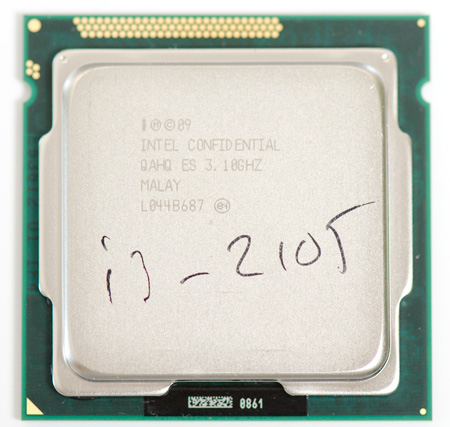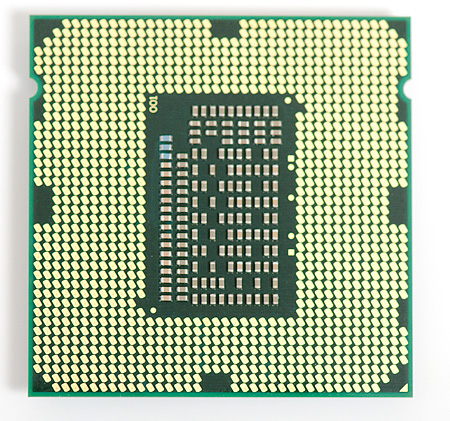The AMD A8-3850 Review: Llano on the Desktop
by Anand Lal Shimpi on June 30, 2011 3:11 AM ESTThe Direct Competitor: Intel's Core i3-2105
When Intel launched Sandy Bridge the only way you could get the faster integrated graphics option (Intel HD 3000) on the desktop was to buy one of the more expensive K-series chips. The logic didn't make a ton of sense given that lower priced systems are usually the ones that depend on integrated graphics. In the weeks before Llano's arrival however, we met a new member of the Sandy Bridge family - the Core i3-2105:

The 2105 is virtually identical to the 2100 it augments. It's still a dual-core processor (HT enabled) with a 3MB L3 cache . There's no turbo boost and you still get all of the same checkbox features (e.g. Quick Sync, VT-x, no VT-d, no AES-NI, etc...). There are only two differences between these two parts. The i3-2105 has an Intel HD Graphics 3000 core vs 2000 in the 2100, and the 2105 is priced at $134 (one dollar cheaper than the A8-3850).

It's clear that this HD 3000 equipped Core i3-2105 is intended to compete directly with the A8-3850.
The Test
The CPU tests in this review use an identical configuration to everything else in Bench (4GB memory, Intel X25-M SSD, discrete GPU etc...). The table below is for the processor graphics comparisons. All Intel HD 3000 numbers were generated using the Core i3-2105.
All discrete GPUs use our standard GPU testbed (3.33GHz Nehalem). This does prevent our usual efforts to keep our testbeds identical, however with low-end GPUs the contamination should be minimal as we’re GPU bound and then some, rather than being CPU bound.
| CPU: | AMD A8-3850 Intel Core i3-2105 |
| Motherboard: | ASUS P8Z68V-Pro (Intel Z68) ASRock A75 Extreme6 (AMD A75) |
| Chipset Drivers: | Intel 9.2.0.1025 AMD Catalyst 8.862 RC1 |
| Hard Disk: | Corsair P256 SSD (256GB) |
| Memory: | G.Skill DDR3-1866 2 x 4GB |
| Video Drivers: | AMD Catalyst 8.862 RC1 Intel 2372 |
| Desktop Resolution: | 1920 x 1200 |
| OS: | Windows 7 x64 |










99 Comments
View All Comments
silverblue - Thursday, June 30, 2011 - link
So, in other words, you completely skipped over what I posted, especially the comparisons between similarly clocked parts? In that case, you may not recall my saying that comparing to Thuban was unfairly skewed in AMD's favour and that for productivity you'd have to be mad to fork out for a high-end Core 2 Quad that is soundly beaten by Thuban under those very circumstances.I'm not going to spend anymore time on this subject for fear it may cause my brain to dissolve.
silverblue - Thursday, June 30, 2011 - link
We really don't know how Bulldozer will perform. Superior in some areas, inferior in others, perhaps. Its roots are in the server domain so it probably won't be the be-all-and-end-all of desktop performance. Should handily thrash Phenom II though.That is, if they stop pushing it backwards... if they do it anymore we may as well wait for Enhanced Bulldozer. :/ I can only truly see Bulldozer being a 9-12 month stop gap before that appears, and as we know, Trinity is going to use the Enhanced cores instead of first generation Bulldozer cores, so it remains to be seen how long a shelf life the product will have.
duploxxx - Thursday, June 30, 2011 - link
Ivy Bridge before buldozer, oh man you really have no idea about roadmaps...Server and desktop will be there long time before Ivy, if they don't hurry with Ivy even Trinity will be ready to be launched.
j_iggga - Thursday, June 30, 2011 - link
Single and double threaded performance is most important for games.Bulldozer has no chance in that regard. The only hope Bulldozer has is that it outperforms a quad core Intel CPU with its 8 cores in a fully multithreaded application.
L. - Thursday, June 30, 2011 - link
GPU's are most important for games, that and a CPU that can feed your GPU's ;)More and more stuff is using 4+ threads, I'd be surprised if the next benchmark from Crytek isn't vastly multithreaded on the CPU side.
We'll see anyway, but the design choices AMD made for Bulldozer are definitely good, as were their multicore designs that Intel quickly copied - for the best.
frozentundra123456 - Thursday, June 30, 2011 - link
Are you kidding me??? If Bulldozer is so great why do they keep having delay after delay and are showing no performance figures??HangFire - Tuesday, July 5, 2011 - link
Given the number of Nocona CPU's Intel sold- as evidenced by the huge number showing up on the secondary market right now- Intel server shipments won't die even if they have an inferior product (again).The faithful will buy on.
L., you seem to be betting on a jump for Bulldozer that will exceed that of C2D over Netburst. I'm not sure that's even possible. C2D only lacked a built-in memory controller, and that has been fixed. I'll be happy if BD even matches Nehalem in core instruction processing efficiency.
But I agree the more progress AMD makes, the better the market is for all of us, no matter which we buy.
frozentundra123456 - Thursday, June 30, 2011 - link
totally agree with your post. Just a weak gpu tacked on to ancient CPU architecture that could easily be beaten by a 50.00 discrete GPU in the desktop.I can see a place for this chip in a laptop where power savings is important and it is not possible to add a GPU, but for the desktop, I really dont see a place for it.
And I agree that Bulldozer is late to the game and may not perform like the AMD fanboys claim. AMD talks a good game, but so far they have not been able to back it up in the CPU area.
jgarcows - Thursday, June 30, 2011 - link
Can you use OpenCL with the Llano GPU? If so, how does it perform for bitcoin mining?JarredWalton - Thursday, June 30, 2011 - link
Yes, Llano fully supports OpenCL -- it's basically a 5570 with slightly lower core clocks and less memory bandwidth (because it's shared). On a laptop, Llano is roughly half the performance of a desktop 5570 (around 40Mhash/s). The desktop chip should be about 40%-50% faster, depending on how much the memory bandwidth comes into play. But 60Mhash/s is nothing compared to a good GPU. Power would be around 60-70W for the entire system for something like 1Mhash/W. Stick a 5870 GPU into a computer and you're looking at around 400Mhash/s and a power draw of roughly 250W -- or 1.6Mhash/W.In short: for bitcoin mining you're far better off with a good dGPU. But hey, Llano's IGP is probably twice as fast as CPU mining with a quad-core Sandy Bridge.